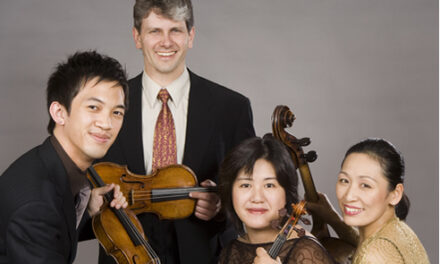The series Sitkovetsky and Friends, which runs parallel to the Greensboro Symphony‘s Classical Series, takes advantage of the peripatetic Maestro’s presence in the Gate City, and often features the visiting guest soloist (along with other members of the Greensboro Symphony) in some of the world’s major chamber music repertory. The location of this exciting concert was the lovely and acoustically pleasing Recital Hall on the campus of the University of North Carolina in Greensboro (UNCG). When the lights were dimmed for the performances, the acoustical clouds overhead glowed orange with light reflected off the wooden floor.
Three works related to Schoenberg were on the program: the original sextet version of his Verklärte Nacht (Transfigured Night), for pairs of violins, violas, and cellos, and his presumed transcriptions of two works by other composers, Claude Debussy’s “Prélude à l’àprès-midi d’un faune” and Johann Strauss’ “Kaiserwaltz” (Emperor Waltz). In fact, it was probably Dr. Benno Sachs, a friend of Schoenberg and the secretary of the Verein für musikalische Privataufführungen (the Society for Private Music Performances), which Schoenberg formed in 1918 to allow contemporary music to be heard in Vienna during the aftermath of World War I, who transcribed Debussy’s masterpiece. (For details, click here and here.)
Verklärte Nacht (Transfigured Night) is an extraordinary work, fragile yet overwhelming, whimsical yet powerful like the lovers it alludes to in the poem by the same title by Richard Dehmel (1863-1920). Austere and simple, yet of a perplexing complexity at moments, this very early work (Opus 4) of the musical giant who would shake the world with his break from tonality a dozen years later is touching in its expressiveness and personal originality. It is a lifetime of emotions presented in one movement, in one half of an hour. In the climax (letter Q in the score), modulation after modulation swirl like painted sand poured on a rotating disk; yet the piece begins and ends firmly anchored in “D.”
And it was superbly played! Maestro Dmitri Sitkovetsky, a great violinist, had picked an excellent cohort composed of John Fadial, concertmaster of the Greensboro Symphony, Scott Rawls, principal viola, and Gizem Yücel, viola, and cellists Beth Vanderborgh and Anne Sellitti, respectively principal and assistant principal, all of the GSO. Precision, delicacy, attention to detail and excellent ensemble work characterized the performance – so much more meaningful than the thick and glossy versions played by full string orchestras. Only a few high notes went sharp, but were quickly altered – but that is live music, so much more meaningful than the best of recordings.
The French poet Stéphane Mallarmé was an inspiration to many poets and musicians, especially Claude Debussy who wrote a musical Prélude to Mallarmé’s L’après-midi d’un faune (“The Afternoon of a Satyr”), the thinly veiled eroticism of which is as much in the voluptuousness of the sounds of the words as in the innuendos and symbolism. Debussy’s score, for a sparse orchestra, is nonetheless imbued with sensuality, both from the extraordinary instrumentation and from the luscious harmonies. This afternoon’s version, directed by Maestro Sitkovetsky, was surprisingly successful in the transcription for string quintet, flute, oboe, clarinet, piano, and accordion (instead of the original harmonium), which did a fine job replacing horns and bassoons. All the familiar flute solos, for which the original is famous, were played with lush liquid warmth by Debra Reuter-Pivetta, principal flute of the GSO. A cameo appearance was made by GSO Board member Carole Moore, who played the antique cymbal’s closing notes, cherished for their clear ringing tone. Lacking, perhaps, was the contrast in tempos and moods for which the work is famous – it was all a bit square.
Not so the last work of the afternoon, a bit of musique de salon, par excellence – Arnold Schoenberg’s transcription of Johann Strauss II’s popular “Emperor Waltz” (Kaiserwaltz) for string quartet, flute, clarinet and piano. It was nice to hear the waltz without the staggering off-kilter “PAH—-pah” that Willi Boskovsky popularized in the last half of the 20th century (Oom- PAH—-pah, etc). Barely letting cellist Vanderborgh finish her exaggerated closing tremolo, the large audience was on its feet applauding enthusiastically, yours truly among them!
These concerts are called Rice Toyota Sitkovetsky & Friends in honor of the Rice Toyota sponsorship. For information on the next one, click here.











